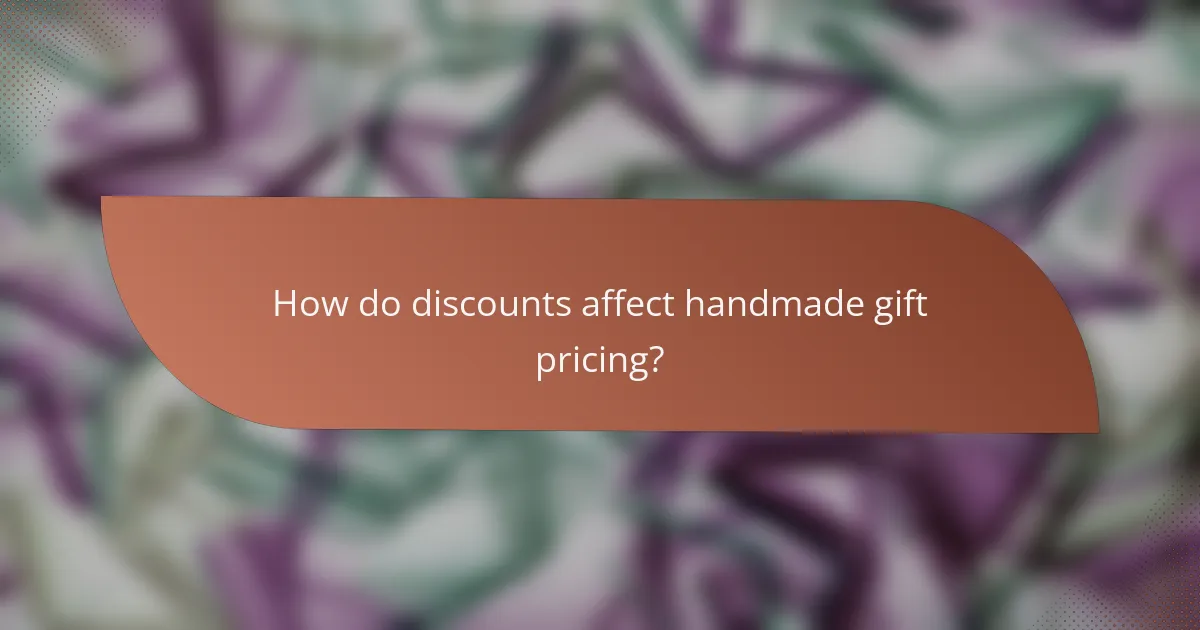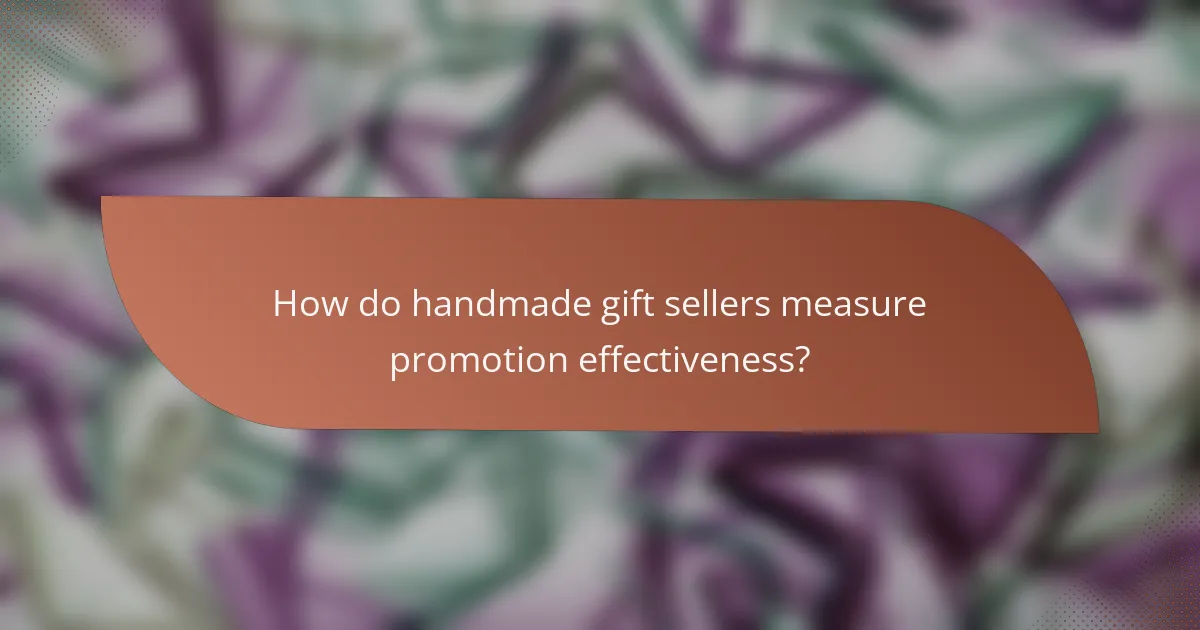Discounts and promotions play a crucial role in shaping the pricing strategy for handmade gifts, as they not only attract customers but also enhance the perceived value of unique products. By implementing effective promotional strategies such as seasonal discounts and bundle offers, sellers can increase customer engagement and drive sales, making their offerings more competitive in the marketplace.

How do discounts affect handmade gift pricing?
Discounts can significantly influence the pricing of handmade gifts by attracting more customers and increasing sales. They create a perception of value that can enhance the appeal of unique products, making them more competitive in the marketplace.
Increased sales volume
Offering discounts on handmade gifts often leads to a rise in sales volume. Customers are more likely to purchase when they perceive they are getting a good deal, especially on unique items that may otherwise be priced higher. For example, a 15-30% discount can encourage impulse buys, especially during holiday seasons or special events.
To maximize the impact of discounts, consider limited-time offers or bundle deals. This strategy not only boosts immediate sales but can also help clear inventory, making room for new creations.
Perceived value enhancement
Discounts can enhance the perceived value of handmade gifts by creating a sense of urgency and exclusivity. When customers see a product marked down, they may believe they are receiving a high-quality item at a lower price, which can elevate their overall shopping experience. For instance, a handmade necklace originally priced at $50 might seem more appealing at a discounted price of $35.
It’s essential to communicate the story behind the handmade item, as this can further enhance its perceived value. Highlighting craftsmanship and unique features can make customers feel they are still making a worthwhile investment, even with a discount.
Competitive positioning
In a crowded marketplace, discounts can help handmade gifts stand out against mass-produced alternatives. By strategically pricing items lower than competitors, artisans can attract price-sensitive customers while maintaining a unique selling proposition. For example, if similar handmade items are priced at $40, offering yours at $30 can draw attention.
However, be cautious not to undervalue your work. Frequent discounts can lead to a perception that your products are less valuable. Instead, consider using discounts sparingly and promoting them as special offers to maintain a premium image.

What types of promotions are effective for handmade gifts?
Effective promotions for handmade gifts include seasonal discounts, bundle offers, and loyalty rewards. These strategies can enhance customer engagement and boost sales by creating a sense of urgency or added value.
Seasonal discounts
Seasonal discounts are time-limited price reductions that coincide with holidays or special occasions, such as Christmas or Valentine’s Day. These promotions can attract customers looking for unique gifts during peak shopping periods.
Consider offering discounts of 10-30% off your handmade items during these times. This not only encourages purchases but also helps clear out inventory to make way for new creations.
Bundle offers
Bundle offers involve selling multiple items together at a reduced price, providing customers with a perceived value. For example, you could offer a gift set that includes a handmade candle and a soap at a lower price than if purchased separately.
This strategy can increase the average order value and encourage customers to try more of your products. Aim for a discount of around 15-25% on the total bundle price to make it appealing.
Loyalty rewards
Loyalty rewards incentivize repeat purchases by offering customers points or discounts based on their spending. For instance, you might provide a 10% discount on their next purchase after they spend a certain amount.
Implementing a simple loyalty program can foster customer retention and encourage word-of-mouth referrals. Consider tracking purchases digitally to streamline the process and enhance customer experience.

How can e-commerce platforms implement discounts?
E-commerce platforms can implement discounts through various strategies that attract customers and boost sales. Effective discount methods include automated discount codes, flash sales, and cart abandonment discounts, each serving different purposes and customer behaviors.
Automated discount codes
Automated discount codes allow customers to apply discounts at checkout without manual intervention. These codes can be generated for specific products, seasonal promotions, or customer loyalty programs. For example, a handmade gift shop might offer a 10% discount code for first-time buyers, encouraging them to complete their purchase.
To implement automated codes, e-commerce platforms should ensure that the process is seamless and user-friendly. Clear instructions should be provided during checkout, and the codes should have an expiration date to create urgency. Avoid overly complicated codes that customers may find difficult to remember or enter.
Flash sales
Flash sales are time-limited promotions that create a sense of urgency among customers. Typically lasting from a few hours to a couple of days, these sales can significantly increase traffic and sales volume. For instance, a store might offer a 30% discount on select handmade items for 24 hours, enticing customers to act quickly.
When planning flash sales, consider promoting them through email newsletters and social media to maximize reach. Ensure that the discounted items are clearly marked on the website, and be prepared for increased customer inquiries during the sale period. However, avoid frequent flash sales, as they can devalue your products in the long term.
Cart abandonment discounts
Cart abandonment discounts are incentives offered to customers who leave items in their shopping carts without completing the purchase. By sending a follow-up email with a small discount, businesses can encourage these potential buyers to return and finalize their transactions. A common practice is to offer a 5-15% discount on the total cart value.
To effectively use cart abandonment discounts, set up automated emails that trigger after a specified period of inactivity, such as 24 hours. Personalize the message to remind customers of the items they left behind and include a clear call to action. Monitor the effectiveness of these discounts to adjust the offer based on customer response rates.

What are the criteria for setting discount strategies?
Setting discount strategies for handmade gifts involves evaluating several key criteria that impact pricing and sales. These criteria include cost analysis, market research, and customer segmentation, each playing a vital role in determining effective discount levels.
Cost analysis
Cost analysis is essential for establishing a discount strategy. It involves calculating the total costs associated with producing handmade gifts, including materials, labor, and overhead. Understanding these costs helps ensure that discounts do not erode profit margins excessively.
When setting discounts, aim to maintain a profit margin of at least 30-50% after applying the discount. This ensures that even with reduced prices, your business remains sustainable. Regularly review costs to adjust your pricing strategy accordingly.
Market research
Conducting market research allows you to understand pricing trends and customer expectations in the handmade gift sector. Analyze competitors’ pricing and promotional strategies to identify what discounts resonate with your target audience.
Utilize surveys or social media polls to gather insights on what potential customers find appealing. This information can guide you in setting discounts that attract buyers while remaining competitive. Aim for discounts that are in line with industry standards, typically ranging from 10-30% for seasonal promotions.
Customer segmentation
Customer segmentation involves categorizing your audience based on demographics, purchasing behavior, and preferences. This helps tailor discount strategies to specific groups, maximizing their effectiveness.
For example, offering exclusive discounts to loyal customers can enhance retention, while targeting new customers with introductory offers can drive initial sales. Consider creating tiered discounts based on purchase volume or frequency, which can encourage larger orders and repeat business.

How do handmade gift sellers measure promotion effectiveness?
Handmade gift sellers measure promotion effectiveness through various methods that provide insights into sales performance and customer engagement. Key metrics include sales tracking, customer feedback, and conversion rates, which help sellers understand the impact of their discounts and promotions.
Sales tracking
Sales tracking involves monitoring the number of items sold during promotional periods compared to regular sales. Sellers can use tools like spreadsheets or e-commerce platforms that offer built-in analytics to record sales data. This helps identify which promotions lead to increased revenue and which do not.
For example, if a seller offers a 20% discount and observes a significant spike in sales, it indicates that the promotion was effective. Regularly reviewing sales data can help sellers adjust their pricing strategies based on what resonates with customers.
Customer feedback
Customer feedback is essential for understanding how promotions are perceived. Sellers can gather insights through surveys, social media interactions, or direct communication with customers. This feedback can reveal whether discounts are attractive and if they influence purchasing decisions.
For instance, asking customers about their thoughts on a recent promotion can help sellers refine future offers. Positive feedback may encourage sellers to repeat successful promotions, while negative responses can guide them to rethink their strategies.
Conversion rate analysis
Conversion rate analysis measures the percentage of visitors who make a purchase after engaging with a promotion. Sellers can calculate this by dividing the number of sales by the total number of visitors during the promotional period. A higher conversion rate indicates that the promotion effectively encouraged purchases.
For example, if a handmade gift seller runs a campaign that attracts 1,000 visitors and results in 100 sales, the conversion rate would be 10%. Monitoring this metric helps sellers understand the effectiveness of their promotional tactics and make data-driven decisions for future campaigns.

What are the risks of discounting handmade gifts?
Discounting handmade gifts can undermine perceived value and profitability. While promotions may attract customers, they can also lead to a devaluation of the artisan’s work and create expectations for lower prices in the future.
Impact on perceived value
When handmade gifts are frequently discounted, customers may begin to view them as less valuable. This perception can diminish the uniqueness and craftsmanship associated with artisanal products, leading to a long-term decline in brand reputation.
For example, if a handmade jewelry piece originally priced at $100 is often seen at $70 during sales, customers may hesitate to pay full price in the future. Maintaining a consistent pricing strategy helps reinforce the value of the product.
Profit margin erosion
Discounting can significantly erode profit margins, especially for handmade items where production costs are often higher. If artisans reduce prices too frequently, they may find it challenging to cover costs and sustain their business.
Consider setting a limit on discounts, such as offering a maximum of 10-20% off during special promotions. This approach can help maintain profitability while still enticing customers.
Customer expectations
Regular discounts can create a cycle where customers only purchase during sales, leading to inconsistent revenue. This behavior can make it difficult for artisans to forecast income and manage inventory effectively.
To mitigate this risk, consider implementing limited-time offers or exclusive promotions for loyal customers rather than blanket discounts. This strategy can help maintain a sense of urgency and exclusivity.
